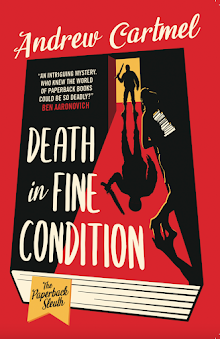 I was working in my kitchen the other day, and thinking about politics. As I do. The radio was playing in the background. I was reflecting on a certain politician and thinking that he was right wing. And, at that exact moment, on the radio, they were talking about cavalry maneouvres at Waterloo and uttered the words "on the right wing."
I was working in my kitchen the other day, and thinking about politics. As I do. The radio was playing in the background. I was reflecting on a certain politician and thinking that he was right wing. And, at that exact moment, on the radio, they were talking about cavalry maneouvres at Waterloo and uttered the words "on the right wing."What do we make of this? Well, nothing. It's just a coincidence, nothing more. But one doesn't have to experience too much of this kind of stuff to begin to be intrigued by synchronicity, strange happenings and parapsychology.
I will admit I'm mildly fascinated by this whole subject (telepathy, ESP, precognition, etc. etc), or at least I would be if it wasn't such an ocean of hokum. I'd love to read more about it, but most of the books available are by cynical crystal-selling charlatans or gullible crystal-buying chumps.
 What I want is a proper, scientific, sceptical, hard-headed account of the subject. The trouble is, most scientists would run a mile (sorry, 1.609344 kilometres) from anything that smacks of parapsychology or the paranormal. There is a terrible danger of ruining their careers by even being associated with such stuff.
What I want is a proper, scientific, sceptical, hard-headed account of the subject. The trouble is, most scientists would run a mile (sorry, 1.609344 kilometres) from anything that smacks of parapsychology or the paranormal. There is a terrible danger of ruining their careers by even being associated with such stuff.Fortunately, the great writer and scholar of science Arthur Koestler was fascinated by the subject and wasn't afraid to delve into it. His slim volume The Roots of Coincidence makes for engrossing reading. It's witty, intelligent, compelling and generally very accessible.
But there remains a problem even with a book as good as Koestler's. Material about the paranormal falls into two categories, subjective personal anecdotes and carefully controlled scientific experiments.

The personal anecdotes are often absolutely rivetting... but ultimately completely unverifiable. Even if a whole bunch of people swear something happened, it still really only amounts to hearsay.
Whereas on the other hand the carefully controlled experiments are utterly reliable... and as dull as ditchwater. They consist of, for example, thousands of repeated attempts to guess which randomly generated number or symbol will pop up next. With the results then subjected to careful statistical analysis. Professor J.B Rhine at Duke University was the poster boy for this kind of research.
And what does the careful statistical analysis tell us? Well, according to the statistics, ESP exists. Beyond question. There is no way the results of innumerable experiments could have been achieved by chance. But although the facts may be irrefutable, no respectable scientist can stomach this sort of thing... Warren Weaver said "I end by concluding that I cannot explain away Rhine's evidence, and that I also cannot accept his interpretation."
 Another study was conducted by Professor William McBain at the University of Hawaii. Reporting about it in New Scientist in 1970, the rigorous and sceptical magazine concluded "chance guessing alone is not enough to explain the results."
Another study was conducted by Professor William McBain at the University of Hawaii. Reporting about it in New Scientist in 1970, the rigorous and sceptical magazine concluded "chance guessing alone is not enough to explain the results."And what has happened in the ensuing 45 years? Well, when Koestler died in 1983 he left his personal fortune to endow a unit dedicated to parapsychology research. They started operating in 1985. One of the founding members was Caroline Watt, who was interviewed by New Scientist in their 25 April 2015 issue, in an article asking, "What has 30 years of research uncovered?"
 The answer is, not a lot. Watt herself seems quite dismissive of the whole question of the paranormal. The only glimmer of interest in her interview concerns some ESP experiments using the Ganzfeld method. Again, the results are statistically significant. But Caroline Watt says, "I'm not persuaded that this provides conclusive evidence for ESP. I am in the camp that thinks there is an anomaly, but I am not sure how to interpret it."
The answer is, not a lot. Watt herself seems quite dismissive of the whole question of the paranormal. The only glimmer of interest in her interview concerns some ESP experiments using the Ganzfeld method. Again, the results are statistically significant. But Caroline Watt says, "I'm not persuaded that this provides conclusive evidence for ESP. I am in the camp that thinks there is an anomaly, but I am not sure how to interpret it."That sound you hear is the planchette rattling around in the box containing your ouija board, as the shade of Arthur Koestler tries to spell out some choice four letter words...
(Image credits: Thank you, Good Reads for the book covers. The New Scientist magazine cover is from Mag Stack. The Ganzfeld image is from Before It's News.)




No comments:
Post a Comment